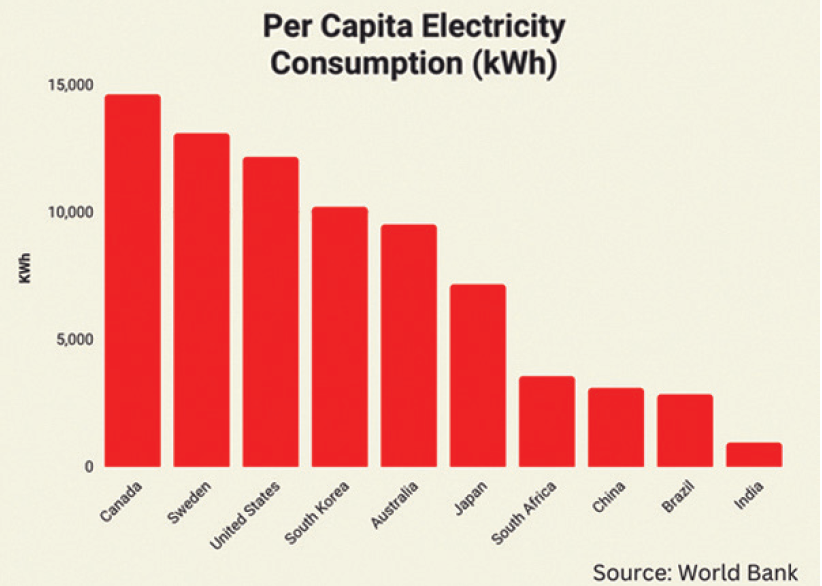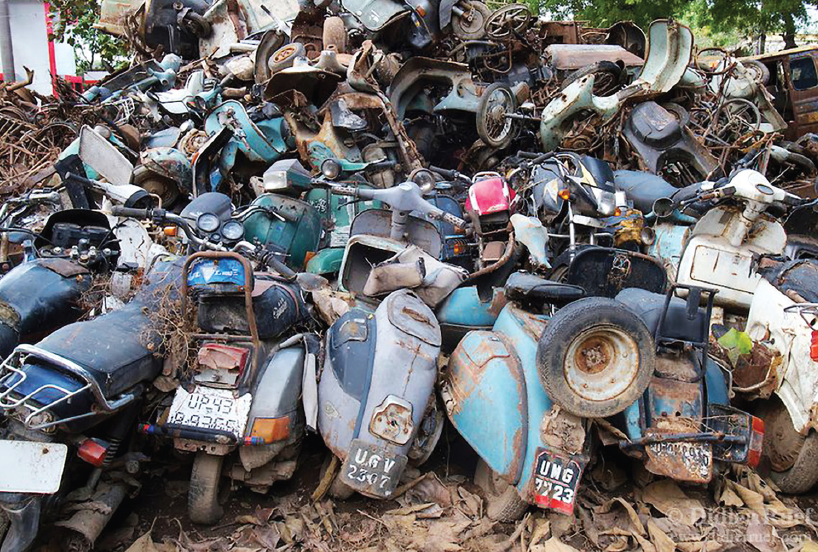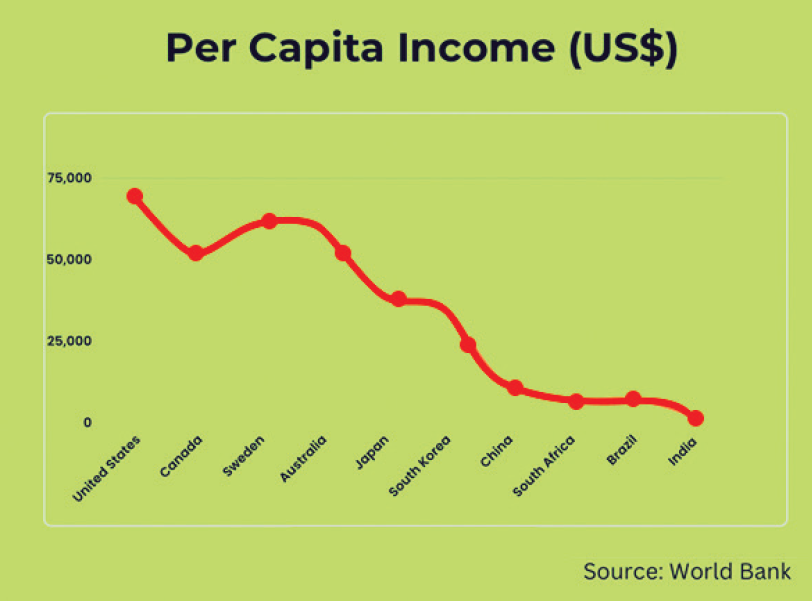As India breaks the shackles of poverty and climbs up the ladder of economic and material well-being, it will inevitably cause increased carbon emissions and perhaps even global warming. But it must not pay heed to green activists from developed countries and their Indian allies who want ordinary Indians to sacrifice a better quality of life at the altar of climate change
By Sutanu Guru
- How does one balance the demands of environmental activists to reduce carbon emissions with the demands of ordinary Indians to improve their quality of life
- Environmental activists from developed countries are pressuring India to reduce carbon emissions, which could negatively impact India’s middle-class aspirations
- Environmental activists in India and developed countries are opposing new coal mining and nuclear power plant projects, which could effect India’s energy demands
- The green movement began with books such as Silent Spring, Limits to Growth, and Small is Beautiful, but has become more extreme in recent years

Santosh Meher, 35 years old is facing a dilemma that his father finds quite amusing. Living in a village near the town of Raigarh in Chhattisgarh, the Mehers have travelled from subsistence to prosperity in forty odd years. Once upon a time, Santosh’s father and grandfather, both illiterates eked out a living on two and half hectares of farmland. There was barely any surplus to sell in the market. But things changed dramatically when irrigation came in and productivity soared. Santosh, who has a graduate degree in agriculture science, added fruits and vegetables to the family farms. Being entrepreneurial, he also launched a transport business that feeds the large steel plant operating out of Raigarh by Jindal Steel & Power.
What is the dilemma confronting Santosh? His wife, very active on social media, insists that the third AC they purchase for their home should be a “pricey” brand like Daikin. His father didn’t even know what an AC was while growing up.
A few thousand kilometres to the west, Prithviraj Singh Jadeja from Mandvi in Kutch, Gujarat too faces a new kind of dilemma. His family was once on the edge of poverty as the 10 hectares of land they tilled in arid and desert like Kutch didn’t produce much. The arrival of Narmada waters have made the Jadeja multimillionaires growing cotton, vegetables and exotic fruits. Prithvi and his brothers are arguing about which SUV they will buy: opinions range from Toyota Fortuner to Kia Seltos to Hyundai Creta. They already have a Mahindra Scorpio.
Social Climbers
There are tens of millions of Indians like Santosh and Prithvi emerging in India. They and their families have not only escaped poverty, but actually managed to become bona fide members of the middle class. They are buying double door refrigerators, fancy kitchen equipment, smart TVs, air conditioners, cars, SUVs and much else. Even their less fortunate counterparts have escaped poverty and are categorised as aspirational Indians. They too are buying millions of ceiling fans, air coolers, two wheelers, smart phones, smart TVs, food processors, refrigerators and more. There is a near consensus among economists and analysts that India will be the fastest growing major economy for the rest of this decade, adding tens of millions to the comfortable middle class and hundreds of millions to the aspirational class by 2030.
After plundering the plate, its resources and after polluting the environment recklessly for about
250 years, what right do people in rich and developed nations have to ask hitherto poor folks in countries like India to sacrifice their material needs and comforts at the altar of climate change?
Many things will change as a consequence. One significant change will be a sustained growth in demand for and consumption of electricity. In 2000, power consumption in India aggregated 354 billion units. By 2022, it had crossed 1500 billion units. By 2030, India will consume 2300 billion units of energy. No matter how hard policy makers push to incentivise renewable energy, fossil fuels like coal, gas and oil will account for the bulk of energy and power generation in the country. Yet, if the almost evangelical zeal of environmental activists in the west and their allies in India have their way, hundreds of millions of Indians like Santosh and Prithvi along with their families will be deprived of a comfortable middle-class existence in the name of climate change and environmental protection. No matter which way one looks at it, energy consumption in India will grow on a sustained basis for a few decades. More Indians will buy two and four wheelers, more Indians will fly, more will use public transport, more will buy gadgets of all kinds that need electricity for both running and charging, more digital transactions will need massive power sources to run the ecosystem…the list could go on and on. How does one balance the demands of environmental activists to reduce carbon emissions with the demands of ordinary Indians to improve their quality of life and material comforts?
Virtue Signalling
The inevitable, albeit cliched question needs to be asked: after plundering the plate, its resources and after polluting the environment recklessly for about 250 years, what right do people in rich, developed nations have to ask hitherto poor folks in countries like India to sacrifice their material comforts at the altar of climate change? The dangers are real. It is possible that virtue signalling hysteria will lead to a situation where petrol based two wheelers are junked and electric two wheelers are made mandatory. This will deprive aspirational Indians of personal mobility since electric two wheelers are too expensive, and it will be ages before charging them becomes both accessible and affordable.

Virtue signalling has already destroyed the livelihoods of tens of thousands of families involved in the firecracker business in Tamil Nadu. A slew of scientific studies have demonstrated that the bursting of firecrackers during Diwali leads to a big spike in pollution. But that lasts only a few days and firecrackers are an insignificant and tiny source of pollution in cities like Delhi. Yet, firecrackers have been totally banned, without any improvement in the air quality in Delhi. Generators are routinely banned in the National Capital Region. The victims are middle class families and small shopkeepers who bear the brunt of power cuts.
The accompanying chart clearly reveals how comparatively ordinary Indians are deprived of electricity. If per capita electricity consumption is to rise to the level of even lowly placed Brazil in the next decade and half, power generation and consumption will need to triple. Inevitably, that will lead to a big jump in carbon emissions from India as it will be the most populous country on earth. Inevitably, there will be pollution and damage to the environment. But look at the irony of it. The new high priestess and Nobel nominated activist of environmentalism Greta Thunberg has taken it upon herself to lecture and hector ordinary folks in Third World and emerging countries to reduce their carbon footprint. The per capita electricity consumption of her country Sweden is more than 13 times that of India.

Currently, large sections of the developed world have been gripped by woke virtue signalling and hysteria. It is already being reflected in policy changes. In 2022 in California, even as people wilted under a massive heat wave, the “liberal” Governor Gavin Newsom urged fellow citizens to switch off their ACs between 4 PM and 9 PM and asked owners of electric vehicles to limit charging their vehicles. The same year, the government in Germany mandated that halls and corridors in public buildings will no longer be heated, private swimming pools will no longer be heated and that the maximum temperature in office buildings shall not exceed 19 degrees celsius, among other things.
It is possible that virtue signalling hysteria will lead to a situation where petrol based two wheelers are junked and electric two wheelers are made mandatory. This will deprive aspirational Indians of personal mobility since electric two wheelers are too expensive, and it will be ages before charging them becomes both accessible and affordable
The author is far from being an alarmist. But even a realistic assessment makes it evident that developed countries egged on by the likes of Greta Thunberg might enact policies that will bar imports from countries that do not follow emission and environmental protection or so dictated by those countries. The intentions may be ostensibly noble: to save the planet from devastating climate change. But the impact on poorer countries like India that need to massively increase energy consumption will be no different than the insidious effects of Imperialism. Barring a few nut cases, almost everyone is convinced that global warming, climate change and environmental damage are serious concerns that could possibly damage livelihoods of even ordinary citizens. A nationwide survey conducted by CVoter for Yale Program on Climate Change Communication reveals that 54% of Indians are alarmed by the potential damage caused by climate change and 29% are concerned by it. Only 7% of Indians are not worried about the impact of climate change. Of the alarmed category of Indians, 74% and 64% of those who expressed concern stated during the CVoter survey that they want the government to do more to mitigate the impact of global warming and climate change. But while a majority want a transition from fossil fuels to renewable energy, they are absolutely against sudden, immediate and drastic changes. They want change, but at a gradual pace.
Green Alarmism
The likes of Greta Thunberg want immediate and drastic change. It wasn’t so hysterical when the “Green” movement started gathering momentum many decades ago. Three books had a dramatic and profound impact on environmental protection as a movement and a credo many decades ago. The first one called The Silent Spring authored by Rachael Carson was published in 1962. It chronicled the extensive damage on soil and other forms of life caused by indiscriminate use of pesticides. The book eventually led to a ban on the use of pesticides like DDT. Two other books published in 1973 too had a huge impact on the movement. One was called Limits to Growth that postulated that resources were finite, and their relentless plunder would lead to natural resources running out by the middle of the 21st century.
The book, in many ways, created the “alarmism” that is so visible in “green” activists in recent times. For instance, it forecast that the world would run out of oil by the 2020s. The third book was called Small is Beautiful authored by economist E F Schumacher. It advocated that smaller, localised and energy efficient solutions were superior to the “Bigger the Better” philosophy pursued by Americans. The oil crisis of 1973 underscored the urgency of the book and its wild popularity. The German car Beetle became an iconic Hollywood star in a series of “Herbie” movies that advocated small is beautiful. Those were days of romantic and idealism driven environmentalism. Today, the movement is marked by hysteria and hectoring.
As mentioned earlier, green activists in the developed world and their allies in India have been adopting a “take no prisoners approach” when it comes to balancing environmental protection with the genuine needs of hundreds of millions of Indians to increase their energy consumption so that their material quality of life can improve. By what logic or morality can one deny Santosh a Daikin AC in Chhattisgarh or a Prithvi in Kutch, Gujarat a brand-new SUV? Activists have been stubbornly opposing any new coal mining project in Chhattisgarh, Jharkhand, Madhya Pradesh among other states. Back in 2012, protestors created such a ruckus that the Kundukulam nuclear plant project has been effectively stalled.

More recently in 2018, “activists” resorted to wanton violence while protesting against the expansion plans of the Sterlite copper plant in Thoothukudi in Tamil Nadu. Wanton police firing in retaliation killed 13 people and the copper plant has been shut since then for five years. India has transitioned from being a net exporter of copper to a net importer. Tens of thousands of locals who have lost their livelihoods have been pleading for the plant to be reopened since scientific studies have demonstrated pollution by the copper plant was not so dangerous. No luck as activists still hold sway.
Such instances abound. Perhaps the most contentious of them was the “war” over the Narmada Dam. Planned and launched by Jawaharlal Nehru, the Narmada Dam remained a distant dream for citizens in Madhya Pradesh, Gujarat and Rajasthan. When the project gathered momentum in the 1990s under a Congress Chief Minister Chimanbhai Patel in Gujarat, all hell broke loose. Supported by a bevy of global green organisations, activist Medha Patkar launched a movement against the project. So powerful were the lobbies that even the World Bank succumbed and announced it was stopping all funding for the Narmada Dam. In an earlier era, a World Bank withdrawal could have dealt a death blow to the project. But India since the 1990s is no longer so dependent on “aid” from developed countries. The Supreme Court of India has not only enabled the dam, but also upbraided Medha Patkar and fellow activists-global and Indian-for playing fast and loose with data in their court submissions. Without the Supreme Court intervention, the Narmada Dam project would have remained a dream. Now, Prithviraj Jadeja and others like him drive SUVs.
It is easy to dismiss the concept of Environmentalism as the New Imperialism as a wild conspiracy theory of xenophobic Indians. Indeed, there are enough loonies in both the “left” and “right” wing that are convinced developed countries are plotting to thwart the “rise” of India as a global power. That is all nonsense, especially when it comes to the environment. If at all there is a concerted move, it is by Indian activists and civil society groups who have learnt that generous funds from “guilty of historical mistakes” donors pour in profusely when you make a lot of noise. The simple fact is that India is the most populous country in the world. It is the fifth largest economy and will soon become the third largest. It ranks number three after China and the United States in terms of total carbon emissions. As the accompanying chart indicates, the per capita income of India will rise in a sustained manner for the next two decades. India will be a matter of concern even to genuine environmentalists who are not wild-eyed hysterics like Greta Thunberg. To its credit, India is already punching far above its weight in rolling out renewable energy projects. It should continue to do so. And ignore activists and policy makers from the west who think the environment is the new “White Man’s Burden”.
